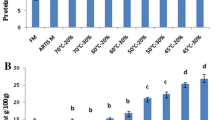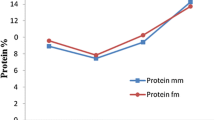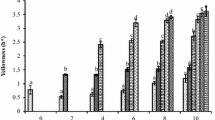Abstract
The chemical composition of European squid (Loligo vulgaris) mantles and tentacles and the lipid oxidation during frozen storage at three different temperatures (−20º, −40º and −80 °C) were investigated. The moisture, fat, protein and ash contents of tentacles were 80.72%, 1.44%, 16.16% and 1.63% while the same contents for mantle were 78.54%, 1.37%, 18.52% and 1.45% respectively. The initial free fatty acidity (FFA), peroxide (PV) and thiobarbituric acid reactive substances (TBARS) values of tentacles were 1.17%, 1.80 meq O2/kg fat and 0.80 mg malonaldehyde/kg respectively. The same results for mantles were 1.38%, 2.20 meq O2/kg fat and 0.73 mg malonaldehyde/kg respectively. PV and TBARS values increased with the storage time for all samples and higher storage temperature resulted with higher PV and TBARS values. The initial fatty acid compositions of L. vulgaris mantles were 29.95% saturated (SFAs), 9.95% monounsaturated (MUFAs) and 59.31% polyunsaturated fatty acids (PUFAs) and tentacles were 34.16% SFAs, 10.69% MUFAs and 55.15 PUFAs. SFAs content were increased but MUFAs and PUFAs contents were decreased during frozen storage of mantles and tentacles.
Similar content being viewed by others
References
AOAC (1999) Official method of analysis, 16th edn. Association of Official Analytical Chemists, Washington, DC
Apgar ME, Hultin HO (1982) Lipid peroxidation in fish muscle microsomes in frozen stage. Cryobiology 19:154–62
Auburg SP (1993) Review: interaction of malondialdehyde with biological molecules-new trends about reactivity and significance. Int J Food Sci Technol 28:323–335
Bligh EG, Dyer WJ (1959) A rapid method of total lipid extraction and purification. Can J Biochem Physiol 37:911–917
Guerra A, Rocha F (1994) The life history of Loligo vulgaris and Loligo forbesi (Cephalopoda: Loliginidae) in Galician waters (NW Spain). Fish Res 21:43–69
Haard NF (1992) Biochemical reactions in fish muscle during frozen storage. In: Blight G (ed) Seafood science and technology. Fishing News Books, Oxfordshire, pp 176–209
Han TJ, Liston J (1988) Correlation between lipid peroxidation and phospholipid hydrolysis in frozen fish muscle. J Food Sci 53(6):1917–1917
Heen E, Karsti O (1965) Fish and shellfish freezing. In: George B (ed) Fish as food. Academic Press Inc., USA, IV: 355–418
Jeyasekaran G, Jeya Shakila R, Sukumar D, Ganesan P, Anandaraj R (2010) Quality changes in squid (Loligo duvaucelli) tubes chilled with dry ice and water ice. J Food Sci Technol 47(4):401–407
Kreuzer R (1984). Cephalopods: Handling, processing and products. FAO Fisheries Technical Paper 254, p. 108, Rome, Italy
Navarro JC, Villanueva R (2000) Lipid and fatty acid composition of early stages of cephalopods: an approach to their lipid requirements. Aquaculture 183:161–177
Ohashie E, Okamato M, Ozawa A, Fujita T (1991) Characterization of common squid using several freshness indicators. J Food Sci 56(1):161–163
Olley J, Lovern JA (1960) Phospholipid hydrolysis in cod flesh stored at various temperatures. J Sci Food Agric 11:644–652
Ozogul Y, Duysak O, Ozogul F, Özkütük AS, Türeli C (2008) Seasonal effects in the nutritional quality of the body structural tissue of cephalapods. Food Chem 108:847–852
Sinanoglou VJ, Miniadis-Meimaroglou S (1998) Fatty acids of neutral and polar lipids of (edible) Mediterranean cephalapods. Food Res Int 31:467–473
Tarladgis BG, Watts BM, Younathan MT, Dugan L Jr (1960) A distillation method for the quantitative determination of malonaldehyde in rancid foods. J Am Oil Chem Soc 37:44–48
Yamanaka H (1987) Potential index for Freshness of Common Squid (Todarodes pacificus). J Food Sci 52(4):936–938
Author information
Authors and Affiliations
Corresponding author
Rights and permissions
About this article
Cite this article
Atayeter, S., Ercoşkun, H. Chemical composition of European squid and effects of different frozen storage temperatures on oxidative stability and fatty acid composition. J Food Sci Technol 48, 83–89 (2011). https://doi.org/10.1007/s13197-010-0139-5
Revised:
Accepted:
Published:
Issue Date:
DOI: https://doi.org/10.1007/s13197-010-0139-5




